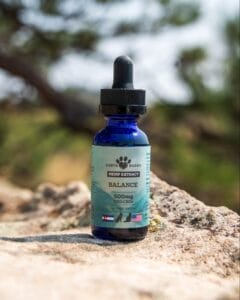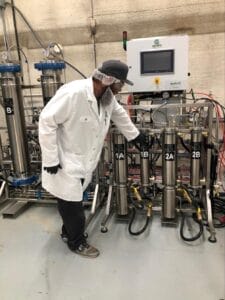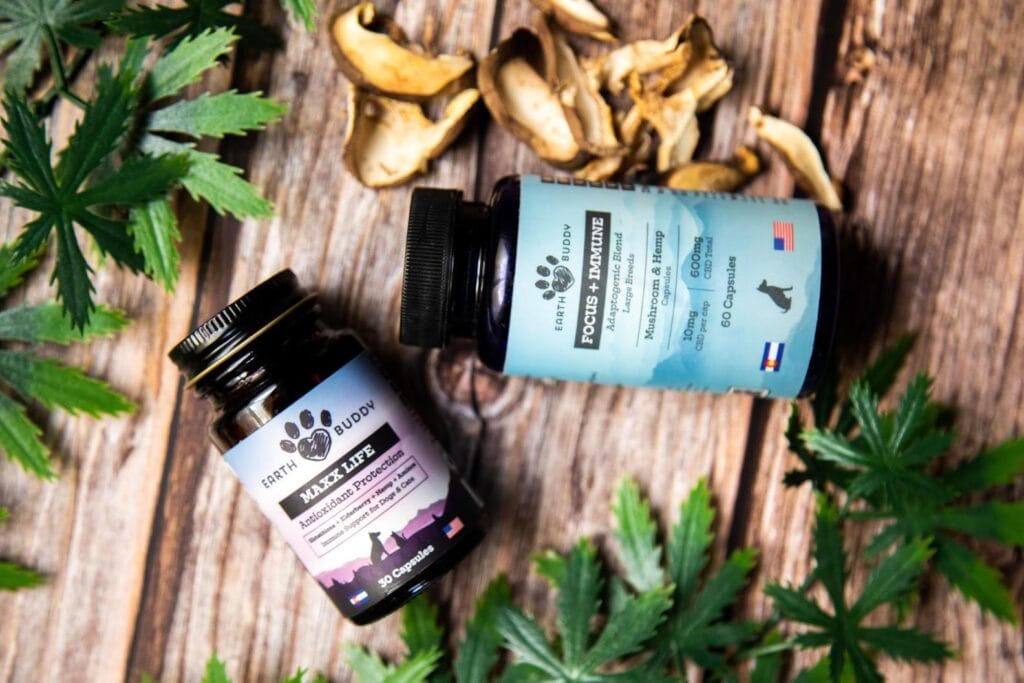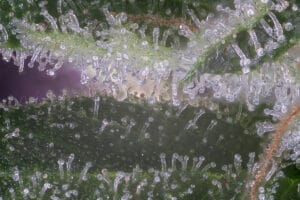In the beginning, the talk was about CBD, but as science unveils new facts, there’s so much more than what was thought in the beginning. Beyond the widely recognized components like THC and CBD, the plant boasts a plethora of other cannabinoids. Each of these is now under the microscope for potential health benefits. A common query from both dog owners and those exploring CBD for personal use is, “Does full spectrum CBD have CBDa?”
For those just dipping their toes into the world of cannabis, there’s keen interest in understanding CBDa oil’s benefits, how it stands apart from CBD, and whether the advantages can be accessed through broad-spectrum products or CBD isolates.
Hemp Plant and Cannabis Plant: Cannabinoids Explained
Cannabinoids are a group of active compounds found in the cannabis or hemp plant. They interact with specific receptors in the body, primarily in the brain and immune system, to produce a range of effects. The most well-known cannabinoids are tetrahydrocannabinol (THC) and cannabidiol (CBD).
There are many other cannabinoids in the cannabis plant, but most are present in small amounts and have not been studied as extensively as THC and CBD. These include cannabinol (CBN), cannabigerol (CBG), cannabichromene (CBC), and tetrahydrocannabivarin (THCV), among others.
The body also produces its own endogenous cannabinoids known as endocannabinoids, such as anandamide and 2-arachidonoylglycerol (2-AG). These endocannabinoids interact with the endocannabinoid system to promote homeostasis.
Why Do Cannabinoids Matter in Hemp Oil?
Cannabinoids hold significant importance due to their complex interactions with the endocannabinoid system (ECS) in the mammalian body. The endocannabinoid system is a vast network of receptors and neurotransmitters that play a critical role in regulating a variety of physiological processes, including but not limited to:
- Supporting the immune system
- Helping maintain normal function of reproductive processes
- Helping decrease oxidative damage
- Promoting a sense of relaxation and mental alertness without drowsiness
- Supporting cardiovascular health
- Promoting long-term ocular health
- Supports a healthy gut
This list is just the beginning. There is significantly more to discuss with regard to the hemp plant and cannabis plant, and how cannabinoids affect each individual system in the body.
Cannabinoids, whether produced by the body (endocannabinoids) or introduced from external sources like the cannabis plant (phytocannabinoids), can influence the mammalian endocannabinoid system, helping keep dogs in peak condition. For instance, CBD promotes a healthy inflammatory response, helps maintain normal emotional balance, and supports normal brain and nerve function.
CBDa Comes From CBGa: CBDa vs CBD
It’s important to understand the difference between CBDa vs CBD. CBGa, or cannabigerolic acid, is often referred to as the “mother” or “stem cell” cannabinoid. It’s the precursor to the three main cannabinoid lines: tetrahydrocannabinolic acid (THCa), cannabidiolic acid (CBDa), and cannabichromenic acid (CBCa).
Through the process of enzymatic reactions in the cannabis plant, CBGa is specifically converted to THCa, CBDa, or CBCa. For instance, when CBGa is exposed to the CBDa synthase enzyme, it is converted into CBDa. Similarly, when exposed to other specific enzymes, CBGa will transform into either THCa or CBCa.
Once these acids are exposed to heat or decarboxylation, they are converted into their neutral forms, THC, CBD, and CBC, respectively. CBDa, for example, becomes CBD. During this transition, they lose their acidity. While there are similarities, it’s important for consumers to know the differences between CBDa vs CBD so the best product for their pet can be chosen.
Other Major Cannabinoid Precursor Compounds
Cannabinoid precursor compounds are the acid forms of cannabinoids that exist in the raw cannabis plant. As stated above, applying heat will convert the acidic form into the neutral form. Here are the major cannabinoid precursor compounds and what they become once heat is applied:
- CBGa (cannabigerolic acid): Often called the “mother” or “stem cell” of cannabinoids. CBGa can be converted to other cannabinoid acids.
- THCa (Δ9-tetrahydrocannabinolic acid): Precursor to THC. When THCa is heated, it becomes the psychoactive compound THC.
- CBDa (cannabidiolic acid): Precursor to CBD. When heated, CBDa converts to CBD.
- CBCa (cannabichromenic acid): Precursor to CBC (cannabichromene).
- CBGVa (cannabigerovarinic acid): Precursor to CBGV (cannabigerivarin).
- THCVa (tetrahydrocanabivarinic acid): Precursor to THCV (tetrahydrocannabivarin).
- CBDVa (cannabidivarinic acid): Precursor to CBDv (cannabidivarin).
- CBCVa (cannabichromevarinic acid): Precursor to CBCV (cannabichromevarin).
Each of these precursor compounds has a unique role in the cannabis plant’s growth and development and may enhance the physical and mental well-being of mammals.
How CBDa Interacts With the Endocannabinoid System
The endocannabinoid system consists of a network of receptors throughout the body, primarily known as CB1 and CB2 receptors, along with endocannabinoids and enzymes that help produce and break down these endocannabinoids.
Each receptor type is found in a different part of the body. CB1 receptors are primarily found in the central nervous system (brain and spinal cord), the peripheral organs and tissues (lungs, liver, and uterus), and the gastrointestinal tract. CB2 receptors are primarily associated with the immune system, but they can also be found in the peripheral nervous system, bone tissue (particularly bone-forming osteoblasts and bone-resorbing osteoclasts), as well as the liver, skin, and peripheral organs and tissues.
The ECS plays a key role in promoting homeostasis in the body.
Indirect interactions: Like CBD, CBDa for dogs and cats doesn’t directly bind to CB1 or CB2 receptors in the endocannabinoid system with high affinity. Instead, it seems to influence the system indirectly. CBDa may affect the levels or activity of endocannabinoids in the body.
Serotonin receptors: CBDa for dogs and cats may have a strong affinity for the 5-HT1A serotonin receptor, potentially even more than CBD. Serotonin is a neurotransmitter that plays a crucial role in helping maintain calmness, supporting a healthy appetite, and other physiological functions. By interacting with these receptors, CBDa might offer potential benefits, especially in helping manage normal stress.
COX-2 inhibition: CBDa for dogs and cats has shown to interact with an enzyme known as COX-2. This interaction may help ease aches and discomfort caused by training and competition, maintain a normal inflammatory cytokine cascade, and aid in occasional joint discomfort.
Potential enhanced bioavailability: CBDa for dogs and cats has shown to support bioavailability, meaning it may assist in the digestion and absorption of other cannabinoids, like CBD, and essential nutrients.
Diverse Health Benefits of CBDa Oil for Dogs & Cats
While research on CBDa is not as extensive as on CBD, several potential CBDa benefits have been found and continue to be explored, including:
Supports Immune System Function: CBDa may enhance the immune response, supporting a healthy immune system in all animals.
Supports balanced behavior: While most of the attention has been given to CBD, there’s growing interest in CBDa’s potential to help reduce the effects of normal environmental stress.
Antioxidant protection: Like many cannabinoids, CBDa supports cellular health by preventing free radical damage, which may help protect body cells and tissues.
Supports normal brain function: CBDa may enhance your pet’s brain function and help support normal behavior patterns.
Help maintain the general health of all ages and breeds: Some cannabinoids, including CBDa, may promote the body’s innate resistance to pathogens.
May help curb destructive behavior: CBDa may influence the 5-HT serotonin-producing receptors, which could be instrumental in promoting a calming effect on nerves.
Helps maintain joint mobility: CBDa may help support the structural integrity of joints and connective tissues, helping relieve occasional joint stiffness in pets.
Do Full Spectrum CBD Oils Have CBDa?
CBDa can be found in both full spectrum CBD oils and broad spectrum CBD oil products, but the concentrations and presence might vary depending on the extraction process and product formulation.
Full spectrum CBD oils contain all the phytochemicals that occur naturally in the cannabis plant, including various cannabinoids, terpenes, and essential oils. It should include CBD, CBDa, THC (usually in amounts less than 0.3% for hemp-derived products to be legally sold in many places), and many other cannabinoids. Since full spectrum CBD oil is typically a whole plant extract, it retains more of the natural cannabinoids, including CBDa.
Broad spectrum CBD oil products contain an array of cannabinoids but exclude THC and most terpenes. Since THC is removed from broad spectrum CBD oil products, some of the other cannabinoids might also be removed or present in lower concentrations than in a full spectrum CBD oil products. To see how much CBDa there is in a particular product, or if there is any, check the product’s lab report or Certificate of Analysis (COA) to be sure.
CBD Isolate Isn’t The Same As Broad Spectrum CBD Oils
CBDa isn’t generally found in CBD isolate, unless it’s in extremely minute quantities. CBD isolate is, as the name suggests, the isolated form of the CBD molecule. It’s processed to remove all other compounds, resulting in a crystalline powder that is 99% pure CBD. This means it contains neither other cannabinoids like CBDa, THC, or CBG nor terpenes, flavonoids, or any other plant compounds found in the cannabis plant. It’s just pure cannabidiol.
Products Containing CBD and CBDa
Earth Buddy offers two products that focus on CBD and CBDa. These products differ in what they may be used for. Consumers looking to help maintain calmness in their pet may choose Balance Hemp Extract. Pet parents searching for a product to help relieve occasional joint stiffness may be more interested in Earth Buddy’s Mobility Hemp Extract.
Balance Hemp Extract For Dogs
Earth Buddy offers Balance Hemp Extract containing CBD and CBDa in equal amounts in a 1:1 ratio. They’re extracted using supercritical Co2 to preserve all of the naturally occurring plant compounds to form what is called the entourage effect. Potential health benefits of utilizing a 1:1 ratio include:
- Recommended for dogs seven years or older to support and maintain proper body functions and overall good quality of life
- The blend of CBDa & CBD enhances the physical and mental well-being of an animal.
- Helps maintain contentment during separation, travel, motion sickness and tension caused by changes in your pet’s daily routine.
- Promotes a sense of relaxation and mental alertness without drowsiness
As a general guideline, provide your dog with .25 mL per 20 lbs of body weight, one to two times each day.
Mobility Hemp Extract For Dogs
Mobility Hemp Extract is also available, containing CBD and CBDa in a 4:1 ratio for those searching for CBDa oil in higher concentrations for their pets. This product was specifically designed to support joint health in pets. The health benefits of choosing a product with a high amount of CBDa include:
- Helps maintain healthy bone & joint function
- Supports normal recovery from stress
- Helps maintain a normal inflammatory response
- Supports healthy joints and flexibility
- Eases joint stiffness due to normal daily exercise and activity
Similar to Earth Buddy’s Balance Hemp Extract, you start at low doses of .25mL per 20 lbs of body weight, one to two times daily.
Maxx Life Glutathione Capsules
Maxx Life was designed to support the whole body system in dogs and cats and contains a unique trio of CBD, CBG, and CBDa for dogs and cats in a Kief form. The Hemp Essence Trinity is a comprehensive blend of perfectly intact trichomes to engage a pet’s endocannabinoid system in various ways. Maxx Life also contains liposomal Glutathione, to enhance antioxidants in dogs and cats bodies. Additional health benefits of Maxx Life Glutathione for dogs and cats are:
- Eliminates oxidative stress associated with pet’s aging process
- Supports pets ability to defend against pathogens
- Increases antioxidant production in pet’s to defend against free radical damage
- Promotes detoxification process defending against liver cell damage
- Fortifies immune system by supporting healthy liver function in pets
The lab results, or COA, for all products can be found by clicking here.
Earth Buddy’s Sourcing and Procedures
Earth Buddy takes the utmost care in sourcing materials for high-quality products. That’s why all organic hemp is grown locally on their farm in Colorado! Earth Buddy is not a commodity-based hemp product. There is heavy emphasis on a small-batch approach, growing on no more than 4 acres at a time to produce potent, quality hemp plants.
All plants at Earth Buddy’s farm must meet certain standards and are consistently tested to ensure that they meet Earth Buddy Pet’s product requirements. All Earth Buddy products are made from organic, non-GMO, pesticide free hemp plants. When hemp is harvested in the fall, the plants are hung in a temperature controlled facility to allow proper drying time prior to extraction.
Once the hemp plants are dried, the leaves and buds (or flowers) of the hemp plant are trimmed and ready for extraction. Earth Buddy utilizes the supercritical Co2 extraction process that involves pressure and temperature, which yields a raw extract that contains the full-spectrum of cannabinoids and terpenes found naturally in the hemp plant. This raw, viscous hemp extract would contain high levels of CBDa until it is decarboxylated (or heated) to convert CBDa into CBD.
Another revolutionary and extremely rare method Earth Buddy uses specifically for our Focus+Immune mushroom capsules, Maxx Life Glutathione capsules, and Gut Health Colostrum products is our solventless Kief. This method utilizes a traditional practice of “bubble hash” taken to a new level where we preserve perfectly intact trichomes of the hemp flower. This allows for a precise dosage of pure plant medicine without adulterating the minor cannabinoids, terpenes, and other volatile compounds. Cannabinoids and terpenes work synergistically and providing a more abundant full spectrum hemp extract for pets allows for a safer and effective pet supplement.
Why is a Certificate of Analysis Important?
Once you have found a product or products you prefer, it’s important to search for a Certificate of Analysis or a lab report. Don’t go one step further until you are able to see exactly what you’re buying. A Certificate of Analysis or lab report) is crucial for CBD supplements for several reasons, including:
Verifying potency: A COA will provide accurate information on the concentration of CBD and other cannabinoids, like CBDa, in the product. This ensures that consumers are getting what they’re paying for and that the product contains the advertised amount of CBD, CBDa, CBG, or any other cannabinoid they’re looking for.
Ensuring safety: The COA, or lab report, will also report on any potential contaminants in the product, like heavy metals, pesticides, solvents, and mycotoxins. It’s vital to ensure that the CBD product is free from harmful substances.
Avoiding illegal levels of THC: Even if a product is labeled as ‘CBD’, it might contain THC (tetrahydrocannabinol). While many states and organizations allow a maximum of 0.3% THC concentration in CBD products, consumers need to be sure they’re not unwittingly purchasing higher (and possibly illegal) levels. A COA will verify THC concentrations.
Transparency and trustworthiness: A company that provides a 3rd party lab report (COA) demonstrates transparency and commitment to quality and safety. It’s a sign that the company is willing to undergo third-party testing and be open about the results, which builds trust with consumers.
Consistency: COAs can also indicate batch-to-batch consistency. If you’re looking for CBD to promote and support long-term health, this is an important factor.
Full-spectrum, broad-spectrum, or isolate: A COA can validate whether a product is full-spectrum (containing multiple cannabinoids and terpenes), broad-spectrum (multiple cannabinoids, typically without THC), or an isolate (pure CBD). Each has its own characteristics, so it’s important to know precisely what you’re getting.
In a market that’s rapidly growing and somewhat saturated, having third-party test results via a COA or lab report is an essential tool for consumers to ensure the safety, quality, and authenticity of their CBD products. Always request and review the COA before purchasing any CBD product. If you don’t see one advertised, request one from the company. If they aren’t willing to provide it, move on to the next product.
How to Read The Lab Report For Full Spectrum Hemp Oil
Reading a Certificate of Analysis (COA) or third-party lab report for hemp oil can seem daunting initially, but with a bit of understanding, it becomes easier. Here’s a guide to help you navigate a COA:
Lab details: Check that the lab report is from a reputable, third-party lab. It shouldn’t be associated with the manufacturer or the brand selling the CBD product. You shouldn’t see the logo of the company that is selling the product as the scientific organization that conducted the report.
Product identification: Ensure the COA pertains to the product you’re examining. Cross-check the product name, batch number, or other identifying details. The batch number for Earth Buddy products can be found on any product on the back or bottom of the packaging. You can also scan the QR codes on any product to access the lab results.
Potency: This section lists the concentrations of the cannabinoids present. Most importantly, check for CBD (cannabidiol) and THC (tetrahydrocannabinol) levels, unless there’s a particular ingredient other than these you’re searching for.
Other cannabinoids: Depending on the product type (full-spectrum, broad-spectrum, or isolate), there might be other cannabinoids like CBG (cannabigerol) or CBN (cannabinol). If you’re looking to purchase a product for a specific cannabinoid, look over the lab report to determine the level of that particular compound.
Terpene profile: If provided, this will show the concentrations of the various terpenes in the product. Terpenes can affect the taste, smell, and characteristics of the product.
Heavy metals: The COA should indicate whether the product was tested for heavy metals such as lead, arsenic, cadmium, and mercury. Ideally, the report should indicate “ND” (Not Detected) next to each metal, although some companies may list these differently.
Microbial testing: This shows whether the product has any microbial contaminants, like fungi or bacteria. “Pass” or “ND” are the results you’d like to see here.
Pesticides, herbicides, and solvents: The CBD product should be free from harmful chemicals. Check this section to make sure harmful pesticides or solvents aren’t present. Again, “ND” or “Pass” is a good sign.
Mycotoxin testing: This tests for toxins produced by fungi. The result should ideally be “ND” or within safe limits.
Visuals: Some COAs might include chromatograms or other visuals, which graphically represent the concentrations of cannabinoids and other compounds. This might be more technical, but it’s a representation of what’s in the product. If you’re a professional in the CBD industry, this could be one of the items you’re looking for.
Limit of quantification (LOQ): This tells you the smallest amount of a compound (like THC or CBD) the lab can detect. If a particular compound is below this level, it won’t show up in the report.
Methodology: Towards the end of a COA, you might see details about the methods and equipment the lab used for testing. This can be technical but is useful for transparency.
Date of testing and signature: Ensure the test is relatively recent to the purchase date. A signature, typically from the lab’s director or a supervising scientist, indicates the lab stands by its results.
Remember, always buy CBD products from brands that provide easy access to COAs. If you’re unsure about the results or need more information, don’t hesitate to contact the brand or the testing lab. If they aren’t willing to be transparent about their product, that is almost always a red flag.
For further reading, we recommend:
You Might Also Enjoy
Reactive dog barking may sound intimidating, but it’s important to differentiate it from dog aggression.…
Your dog’s skin is their largest organ making dog skin care a crucial part of…
Like us, our dogs, and other mammalian species, cats have an endocannabinoid system. This system…












